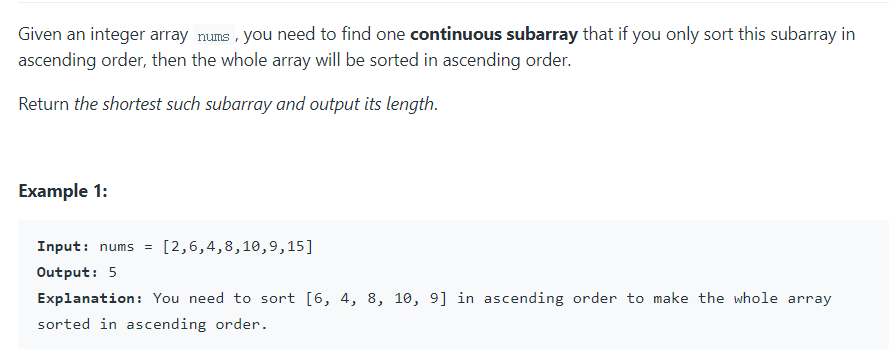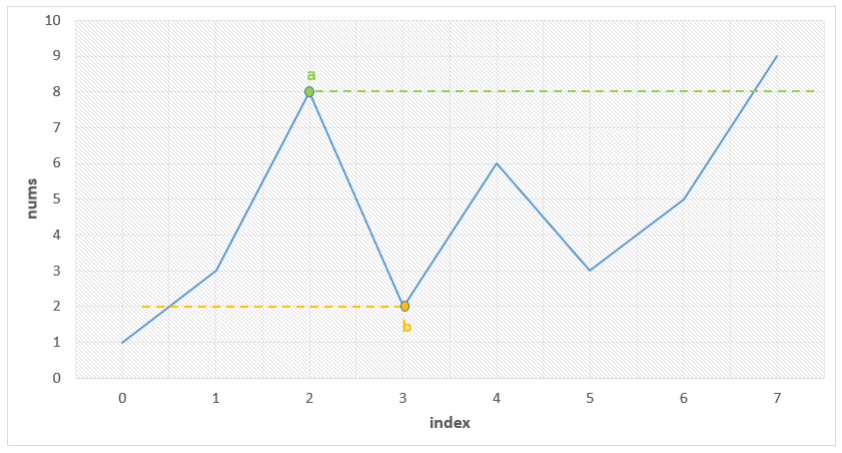最短未排序数组
问题描述
给定一个数组,求它的一个子数组的最短长度,使得该数组完成升序排序后,整个数组也达到升序。

方法1:选择排序思想
模拟选择排序的方法,能够得到每个位置排好序后应该放置的数字,如果这个数字发生了改变,说明这个位置是在所求的子数组内部的,因此通过这种方法能够找到该数组的左边界和右边界,算法复杂度为:时间$O(n^2)$, 空间$O(1)$。
1
2
3
4
5
6
7
8
9
10
11
12
13
14
| public class Solution {
public int findUnsortedSubarray(int[] nums) {
int l = nums.length, r = 0;
for (int i = 0; i < nums.length - 1; i++) {
for (int j = i + 1; j < nums.length; j++) {
if (nums[j] < nums[i]) {
r = Math.max(r, j);
l = Math.min(l, i);
}
}
}
return r - l < 0 ? 0 : r - l + 1;
}
}
|
方法2:比对排序数组
如果有足够大的空间,那么该上面的算法可以直接在排好序之后给每个值一一比对,找出发生改变的位置的左边界和右边界,算法复杂度为:时间$O(n)$, 空间$O(n)$。
1
2
3
4
5
6
7
8
9
10
11
12
13
14
| public class Solution {
public int findUnsortedSubarray(int[] nums) {
int[] snums = nums.clone();
Arrays.sort(snums);
int start = snums.length, end = 0;
for (int i = 0; i < snums.length; i++) {
if (snums[i] != nums[i]) {
start = Math.min(start, i);
end = Math.max(end, i);
}
}
return (end - start >= 0 ? end - start + 1 : 0);
}
}
|
方法3:使用栈
下面两种方法都需要考虑的数字进行了筛选,该问题的核心是找到子数组的左边界和右边界。
对于左边界而言,在排好序后该位置的数字应该是所有降序区间的数字中最小的那个,因为对于该数字前面的数字,它们的顺序已经是升序,因此不需要进行排列。
右边界同理,只需要把考察的方向更换一下。
这个算法的核心是,如果前面的数字大于当前的数字,则入栈,否则将栈中的元素依次弹出,直到放入前面的元素后栈依然是升序的,此时经过处理得到左边界。右边界同理,该算法的复杂度为:时间$O(n)$, 空间$O(n)$。

1
2
3
4
5
6
7
8
9
10
11
12
13
14
15
16
17
18
| public class Solution {
public int findUnsortedSubarray(int[] nums) {
Stack < Integer > stack = new Stack < Integer > ();
int l = nums.length, r = 0;
for (int i = 0; i < nums.length; i++) {
while (!stack.isEmpty() && nums[stack.peek()] > nums[i])
l = Math.min(l, stack.pop());
stack.push(i);
}
stack.clear();
for (int i = nums.length - 1; i >= 0; i--) {
while (!stack.isEmpty() && nums[stack.peek()] < nums[i])
r = Math.max(r, stack.pop());
stack.push(i);
}
return r - l > 0 ? r - l + 1 : 0;
}
}
|
方法4:找特殊极值(最优)
解决问题的核心方法同上,但是不需要使用栈来处理了,因为直接可以直接通过比大小的方式得到左右边界的值。
复杂度: 时间$O(n)$, 空间$O(1)$。
1
2
3
4
5
6
7
8
9
10
11
12
13
14
15
16
17
18
19
20
21
22
| public Solution{
public int findUnsortedSubarray(int[] sums){
int l = 0, r = nums.length - 1;
int min = Integer.MAX_VALUE, max = Integer.MIN_VALUE;
int st = 0, nd = -1;
while(r >= 0){
if(nums[l] >= max){
max = nums[l];
} else {
nd = l;
}
if(nums[r] <= min){
min = nums[r];
} else {
st = r;
}
l++;
r--;
}
return nd - st + 1;
}
}
|

